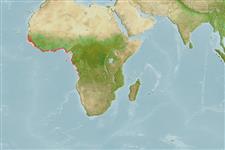Environment: milieu / climate zone / depth range / distribution range
ນິເວດວິທະຍາ
ສັດທະເລ; ນ້ຳຈືດ; ນ້ຳກ່ອຍ ອາໄສຢູ່ໃກ້ໜ້າດິນໃຕ້ພື້ນທ້ອງນ້ຳ; ກຸ່ມປາຫຼຊະນິດປາທີ່ມີການເຄື່ອນຍ້າຍຈາກແມ່ນ້ຳລົງສູ່ທະເລເພື່ອວ່າງໄຂ່ (Ref. 51243); ລະດັບຄວາມເລິກ 0 - 25 m (Ref. 121789). Tropical; 21°N - 20°S, 18°W - 16°E
Length at first maturity / ຂະໜາດ / ນ້ຳໜັກ / Age
Maturity: Lm 17.8 range ? - ? cm
Max length : 41.0 cm FL ຕົວຜູ້/ບໍ່ມີເພດ; (Ref. 57400); common length : 27.0 cm SL ຕົວຜູ້/ບໍ່ມີເພດ; (Ref. 7399); ນ້ຳໜັກສູງສຸດທີ່ເຄຍຈັດພີມມາ: 262.00 g (Ref. 55664)
ຄີ(ໜາມ) ແຂງຢູ່ຄີກົ້ນປາ
ກຸ່ມປາກະດູກແຂງ
ຄວາມຖີ່ຂອງກຸ່ມຖ່າຍທອດພັນ
ປາທີ່ມີການເຄື່ອນຍ້າຍຈາກທະເລໄປຫານ້ຳຈືດ ແລະນ້ຳຈືດຫາທະເລ
ປາທີ່ມີການເຄື່ອນຍ້າຍຈາກທະເລແລະໄປໄຂ່ຢູ່ນ້ຳຈືດ
ຄີກົ້ນຂອງປາ
ສັດທີ່ມີກະດູກສັນຫັຼງ
ການຖ່າຍທອດທາງກຳມະພັນຈາກພໍ່ແມ່ຫາລູກ: 3; ຄີກົ້ນຂອງປາ: 10 - 12. Diagnosis: anal fin with at least 13 (usually 14) rays in total (usually III-11 in adults)(Ref. 81659), 10-11 anal soft rays (Ref. 57400). Scales on flanks cycloid; posterior end of maxilla weakly curved or almost straight; serrate, anteroventral edge of lachrymal weakly concave (Ref. 81659). 12-15 scales in an oblique, transverse series; colour of fins greyish-white; second dorsal, pectoral fins and anal fin distinctly falcate (Ref. 57400).
Euryhaline, tolerating conditions varying from hypersaline to freshwater; favours sandy or muddy substrates (Ref. 81659). Very common in coastal lagoons and estuaries (Ref. 2683, 57400, 81659). Also caught in hypersaline environments (Ref. 57400) and freshwaters (Ref. 7399, 57400, 81659) several kilometres upstream in rivers (Ref. 81659). Feed on plankton and detritus (Ref. 28587). Oviparous, eggs are pelagic and non-adhesive (Ref. 205). Spawning may occur in lagoons or in the sea (Ref. 81659). Possibly reaches up to 500mm FL (Ref. 57400, 81659).
Life cycle and mating behavior
Maturities | ການສືບພັນ | Spawnings | Egg(s) | Fecundities | ຕົວອ່ອນ
Thomson, J.M., 1990. Mugilidae. p. 855-859. In J.C. Quero, J.C. Hureau, C. Karrer, A. Post and L. Saldanha (eds.) Check-list of the fishes of the eastern tropical Atlantic (CLOFETA). JNICT, Lisbon; SEI, Paris; and UNESCO, Paris. Vol. 2. (Ref. 7399)
IUCN Red List Status (Ref. 130435)
Threat to humans
Harmless
Human uses
ການປະມົງ: ເປັນສີນຄ້າ
ເຄື່ອງມື
Special reports
Download XML
ແຫຼ່ງອີນເຕີເນັດ
Estimates based on models
Preferred temperature (Ref.
123201): 23.5 - 27.9, mean 26.5 °C (based on 62 cells).
Phylogenetic diversity index (Ref.
82804): PD
50 = 1.0000 [Uniqueness, from 0.5 = low to 2.0 = high].
Bayesian length-weight: a=0.01122 (0.00978 - 0.01287), b=2.94 (2.90 - 2.98), in cm total length, based on LWR estimates for this species (Ref.
93245).
ຊັ້ນເຂດຮ້ອນ (Ref.
69278): 2.9 ±0.37 se; based on food items.
Generation time: 2.7 ( na - na) years. Estimated as median ln(3)/K based on 1
growth studies.
ຄວາມຢືດຢຸ່ນ (Ref.
120179): ຂະໜາດກາງ, ປະຊາກອນຕຳ່ສຸດທີ່ໃຊ້ເວລາສອງເທົ່າ 1.4 - 4.4 ປີ (Preliminary K or Fecundity.).
Fishing Vulnerability (Ref.
59153): Low to moderate vulnerability (31 of 100).
Nutrients (Ref.
124155): Calcium = 185 [87, 385] mg/100g; Iron = 1.28 [0.62, 2.58] mg/100g; Protein = 18.4 [16.8, 20.0] %; Omega3 = 0.335 [0.171, 0.717] g/100g; Selenium = 48.6 [25.0, 100.6] μg/100g; VitaminA = 16.5 [5.1, 48.3] μg/100g; Zinc = 1.56 [1.10, 2.25] mg/100g (wet weight);
